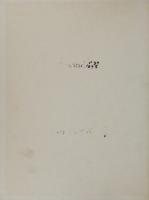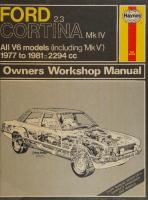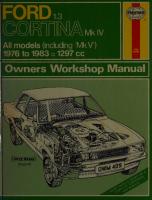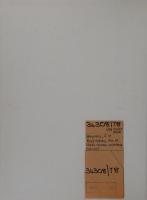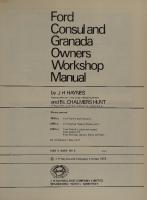Haynes Ford Cortina MkIV 1600 and 2000 Owners Workshop Manual 0856968587, 9780856968587
Haynes Ford Cortina MkIV 1600 and 2000 Owners Workshop Manual - John H. Haynes - Haynes Publishing - 1982.
133 56 28MB
English Pages 252 Year 1982
Recommend Papers
File loading please wait...
Citation preview
(\Terry Davey)
i S
Se
4
Ean
YZ
7
ASO
pie
THE
HAYNES
PUBLISHING
GROUP
The company was formed in 1960 and the first Haynes Owners Workshop Manual, for the Austin-Healey Sprite, was published in 1965. The manual was written from the practical experience of completely stripping and rebuilding the car — a process still used for all manuals today. Since 1960, the Group has grown to become the world’s largest publisher of motoring books. A list of over 330 Owners Workshop Manuals, covering 95% of cars and motorcycles on the roads of Britain, is complemented by a range of Owners Handbooks for many popular cars, as well as other publications covering general maintenance. The Group also publish well over 100 books for motoring and motorcycling enthusiasts under the G.T. Foulis and Oxford Illustrated Press imprints. (See list inside back cover). Foulis, a name associated with publishing for over 400 years, has been producing quality motoring books since before the war. Also from Oxford Illustrated Press are many general interest titles. For further details of the Haynes range of publications, please contact:Haynes Publishing Group, Sparkford, Yeovil, Somerset
BA22
7JJ.
GO HAYNES - GO BY THE BOOK
Ford Cortina IV 1600 and 2000 Owners Workshop Manual by J H Haynes Member of the Guild of Motoring Writers
Models covered: 1600 Standard, Saloon and Estate,
1600 Carousel Saloon and Estate, 1600L Saloon and Estate, 1600GL Saloon and Estate, 1600 Ghia Saloon and Estate 2000GL Saloon and Estate, 2000 Ghia Saloon and Estate, 2000S Saloon,
1593 1593 1593 1593 1593 1993 1993 1993
cc cc cc cc cc cc cc cc
ohc ohc ohc ohc ohc ohc ohc ohc
Does not cover 1300 cc ohv models or 2.3 litre V6 models
ISBN ©
0 85696
858 7
Haynes Publishing Group 1977,1980,1981,1982
All rights any form recording in writing
reserved. or by any or by any from the
No part of this book may be reproduced or transmitted in means, electronic or mechanical, including photocopying, informaticn storage or retrieval system, without permission copyright holder.
Printed in England
(343—2H4)
HAYNES PUBLISHING GROUP SPARKFORD YEOVIL SOMERSET BA22 7JJ ENGLAND distributed in the USA by
HAYNES PUBLICATIONS INC 861 LAWRENCE DRIVE NEWBURY PARK CALIFORNIA 91320 USA
aacor
Acknowledgements Special thanks are due to the Ford Motor Company for the supply of technical information and certain illustrations. Castrol Limited provided lubrication data, and the Champion Sparking Company supplied the illustrations showing the various spark plug conditions. The bodywork repair photographs used in this manual were provided by Holt Lloyd Limited who supply ‘Turtle Wax’, Dupli-color Holts’, and other Holts range products. The section of Chapter 10 dealing with the suppression of radio
interference, was originated by Mr |.P. Davey, and was first published in Motor magazine. Lastly, thanks are due to all of those people at Sparkford who helped in the production of this manual. Particularly, Brian Horsfall and Les Brazier who carried out the mechanical work and took the photographs respectively; Lee Saunders who planned the layout of each page and John Rose the editor. lan Coomber wrote the supplementary Chapter.
About this manual Its aim The aim of this manual is to help you get the best value from your car. It can do so in several ways. It can help you decide what work must be done (even should you choose to get it done by a garage), provide information on routine maintenance and servicing, and give a logical course of action and diagnosis when random faults occur. However, it is hoped that you will make use of the manual by tackling the work yourself. On simpler jobs it may be even quicker than booking the car into a garage, and having to go there twice, to leave and collect it. Perhaps most important, a lot of money can be saved by avoiding the costs the garage must charge to cover its labour and overheads. The manual has drawings and descriptions to show the function of the various components so that their layout can be understood. Then the tasks are described and photographed in a step-by-step sequence so that even a novice can do the work.
Its arrangement The manual is divided into thirteen Chapters, each covering a logical sub-division of the vehicle. The Chapters are each divided into consecutively numbered Sections and the Sections into
paragraphs (or sub-sections), with decimal numbers following on from the Section they are in, eg 5.1, 5.2, 5.3 etc. It is freely illustrated, especially in those parts where there is a detailed sequence of operations to be carried out. There are two
forms of illustration; figures and photographs. The figures are numbered in sequence with decimal numbers, according to their position in the Chapter: eg Fig.6.4 is the 4th drawing/illustration in Chapter 6. Photographs are numbered (either individually or in related groups) the same as the Section or sub-section of the text where the operation they show is described. There is an alphabetical index at the back of the manual as well as a contents list at the front. References to the ‘left’ or ‘right’ of the vehicle are in the sense
of a person ina seat facing towards the front of the vehicle. Unless otherwise stated, nuts and bolts are removed by turning anti-clockwise, and tightened by turning clockwise. Whilst every care is taken to ensure that the information in this manual is correct no liability can be accepted by the authors or publishers for loss, damage or injury caused by any errors in, or omissions from, the information given.
Introduction to the Ford Cortina The initially 1.3 ohv became
Mk IV Cortina was first introduced in 1976 and was available with any one of three basic engine types, the engine or the 1.6 or 2.0 ohc engines. A further version available in 1977 when the 2.3 litre V6 engine was added
to the range. In this manual we deal with the 1.6 and 2.0 litre models, the 1.3 and 2.3 litre versions being covered in separate manuals.
The 1.6 engined model is available in the Base, L, GL or Ghia form, whilst the 2.0 litre model is available in the GL or Ghia form. The original 2 litre S version was discontinued in 1979 and in its place an ‘S pack’ became available on all except the Base model.
Mk
IV
The ‘S pack’ is designed to provide a firmer suspension front and rear, large gas-filled shock absorbers being employed all round in place of the normal hydraulic types, alloy roadwheels are also fitted together with other refinements such as a ‘hockey stick’ gear lever, a tachometer, four-spoke steering wheel and bumper overriders. As an alternative on some Estate models, a ‘Heavy Duty’ pack is available. This offers a strengthened axle casing, larger rear brakes and reinforced radial ply tyres. The suspension is also uprated and
the payload is increased from 935 Ib to 1216 lb.
Contents Page Acknowledgements
2
About this manual
2
Introduction to the Ford Cortina Mk IV
2
Jacking and Towing
6
Quick reference capacities
Buying spare parts and vehicle identification numbers
Safety first!
8
Recommended
lubricants and fluids
9
Routine maintenance
10
Chapter 1
Engine
13
Chapter 2
Cooling system
55
Chapter 3
Carburation; fuel and exhaust systems
63
Chapter 4
Ignition system
81
Chapter5
Clutch
90
Chapter 6
Manual gearbox and automatic transmission
96
Chapter 7
Propeller shaft
116
Chapter 8
Rear axle
120
Chapter9
Braking system
123
Chapter 10
Electrical system
135
Chapter 11
Suspension and steering
169
Chapter 12
Bodywork and fittings
187
Chapter 13
Supplement: Revisions and information on later models
204
Tools and working facilities
240
Fault diagnosis
24 2
@°
a < Oo Sa& Oo => —h@ Q
Index
ot°
=n
NO pf o1
24 oO
|
1S, 9431] J CUIUOD Al AW
Jacking and Towing Jacking points
beneath the car.
To change a wheel in an emergency, use the jack supplied with the
vehicle. Ensure that the roadwheel nuts are released before jacking-up the car and make sure that the arm of the jack is fully engaged with the body bracket and that the base of the jack is standing on a firm level surface. The jack supplied with the vehicle is not suitable for use when raising the vehicle for maintenance or repair operations. For this work,
use a trolley, hydraulic or screw type jack located under the front crossmember, bodyframe sidemembers or rear axle casing, as illustrated. Always supplement the jack with axle stands or blocks before crawling
Towing points If your vehicle is being towed, make sure that the tow rope is attached to a towing eye or the front crossmember. If the vehicle is equipped with automatic transmission, the distance towed must not exceed 15 miles (24 km), nor the speed 30 mph (48 km/h), otherwise serious damage to the transmission may result. If these limits are likely to be exceeded, disconnect and remove the propeller shaft. lf you are towing another vehicle, attach the tow rope to the lower suspension arm bracket at the axle tube.
1946mm
(76:7 in) eS
‘
t 380mm (15 -Oin) Ty
—-510mm--(20-1in)
Tow rope attachment to front of vehicle
Quick reference Engine oil capacity: Excluding filter (oil change only) ... With new filter
Tow rope attachment to rear of vehicle
capacities 5.5 pints (3.15 litres) 6.2 pints (3.55 litres)
Cooling system: 1600 cc 2000 cc
Fuel tank capacity
10.1 pints (5.75 litres) 10.8 pints (6.13 litres)
12 gallons (54 litres)
Gearbox capacity: 1600 cc 2000 cc
Automatic transmission fluid capacity ...
1.6 pints (0.9 litra) 2.6 pints (1.5 litres)
11.1 pints (6.3 litres)
Rear axle capacity: 1600 cc 2000 cc
1.8 pints (1.0 litre) 1.9 pints (1.1 litres)
Buying spare and vehicle
parts
identification
numbers
Buying spare parts
often be found not far from home. Motor factors - Good factors will stock all of the more important components which wear out relatively quickly (eg clutch components,
Spare parts are available from many sources, for example: Ford garages, other garages and accessory shops, and motor factors. Our advice regarding spare part sources is as follows:
pistons, valves, exhaust systems, brake cylinders/pipes/hoses/seals/ shoes and pads etc). Motor factors will often provide new or recon-
Officially appointed Ford garages - This is the best source of parts which are peculiar to your car and are otherwise not generally available
ditioned components on.a part exchange basis - this can save a considerable amount of money.
(eg complete cylinder heads, internal gearbox components, badges,
interior trim etc). It is also the only place at which you should buy Parts if your car is still under warranty - non-Ford components may invalidate the warranty. To be sure of obtaining the correct parts it will always be necessary to give the storeman your car's vehicle identification number, and if possible, to take the ‘old’ part along for positive identification. Remember that many parts are available on a factory exchange scheme - any parts returned should always be clean! It obviously makes good sense to go straight to the specialists on your car for this type of part for they are best equipped to supply you. Other garages and accessory shops - These are often very good places to buy materials and components needed for the maintenance of your car (eg oil filters, spark plugs, bulbs, fan belts, oils and greases, touch-up paint, filler paste, etc). They also sell general accessories, usually have convenient opening hours, charge lower prices and can
Vehicle identification numbers Although many individual parts, and in some cases sub-assemblies, fit a number of different models it is dangerous to assume that just because they look the same, they are the same. Differences are not always easy to detect except by serial numbers. Make sure therefore, that the appropriate identity number for the model or sub-assembly is known and quoted when a spare part is ordered.
The vehicle identification plate is mounted on the right-hand side of the front body panel and may be seen once the bonnet is open. Record the numbers from your car on the blank spaces of the accompanying illustration. You can then take the manual with you when buying parts; also the exploded drawings throughout the manual can be used to point out and identify the components required.
FORD MOTOR CO. LTD. LONDON ENGLAND
Typ/Type Version
Fahrgestell/Vehicle No.
Zul. Gesamtgew. Zu!.Achslast Vorn Zul. Achslasthinten _ Cede ed Vehicle Wot. Perm.Axle ld. Front Perm.Axle Ld.Rear C] NZ Lenk Drive
Motor Getr.. Achse EngineTrans. Axle
Farbe
Baa Polst epee te K.D. Bremsen Trim
Ref.
Brakes
(7abyontalooeae Doe ha AU48:1965_| BS Vehicle identification plate and location
(early type plate shown)
Safety First! Professional motor mechanics are trained in safe working procedures. However enthusiastic you may be about getting on with the job in hand, do take the time to ensure that your safety is not put at risk. A moment's lack of attention can result in an accident, as can failure to observe certain elementary precautions. There will always be new ways of having accidents, and the following points do not pretend to be a comprehensive list of all dangers; they are intended rather to make you aware of the risks and to encourage a safety-conscious approach to all work you carry out on your vehicle.
Essential DOs and DON'Ts DON'T
rely on a single jack when
working underneath
the vehicle.
Fire Remember at all times that petrol (gasoline) is highly flammable. Never smoke, or have any kind of naked flame around, when working on the vehicle. But the risk does not end there — a spark caused by an electrical short-circuit, by two metal surfaces contacting each other, or even by static electricity built up in your body under certain conditions, can ignite petrol vapour, which in a confined space is highly explosive. Always disconnect the battery earth (ground) terminal before working on any part of the fuel system, and never risk spilling fuel on to a hot engine or exhaust. It is recommended that a fire extinguisher of a type suitable for fuel and electrical fires is kept handy in the garage or workplace at all times. Never try to extinguish a fuel or electrical fire with water.
Always use reliable additional means of support, such as axle stands,
Fumes
securely placed under a part of the vehicle that you know will not give
Certain fumes are highly toxic and can quickly cause unconsciousness and even death if inhaled to any extent. Petrol (gasoline) vapour comes into this category, as do the vapours from certain solvents such as trichloroethylene. Any draining or pouring of such volatile fluids should be done in a well ventilated area. When using cleaning fluids and solvents, read the instructions carefully. Never use materials from unmarked containers — they may give off poisonous vapours. Never run the engine of a motor vehicle in an enclosed space such as a garage. Exhaust fumes contain carbon monoxide which is extremely poisonous; if you need to run the engine, always do so in the open air or at least have the rear of the vehicle outside the workplace. If you are fortunate enough to have the use of an inspection pit, never drain or pour petrol, and never run the engine, while the vehicle is standing over it; the fumes, being heavier than air, will concentrate in the pit with possibly lethal results.
Way. DON'T attempt to loosen or tighten high-torque nuts (e.g. wheel hub nuts) while the vehicle is on a jack; it may be pulled off. DON'T start the engine without first ascertaining that the transmission is in neutral (or ‘Park’ where applicable) and the parking brake applied.
DON’T suddenly remove the filler cap from a cover it with a cloth and release the pressure may get scalded by escaping coolant. DON’T attempt to drain oil until you are sure it to avoid scalding you. DONT grasp any part of the engine, exhaust without first ascertaining that it is sufficiently
hot cooling system — gradually first, or you has cooled sufficiently or catalytic converter cool to avoid burning
you. DON’T syphon toxic liquids such as fuel, brake fluid or antifreeze by mouth, or allow them to remain on your skin.
DONT inhale brake lining dust —it is injurious to health DON'T allow any spilt oil or grease to remain on the floor — wipe it up straight away, before someone slips on it. DON'T use ill-fitting spanners or other tools which may slip and cause injury. DON’T attempt to lift a heavy component which may be beyond your capability — get assistance. DON'T rush to finish a job, or take unverified short cuts. DONT allow children or animals in or around an unattended vehicle. DO wear eye protection when using power tools such as drill, sander, bench grinder etc, and when working under the vehicle. DO use a barrier cream on your hands prior to undertaking dirty jobs — it will protect your skin from infection as well as making the dirt easier to remove afterwards; but make sure your hands aren't left slippery. DO keep loose clothing (cuffs, tie etc) and long hair well out of the way of moving mechanical parts.
DO
remove
rings, wristwatch
etc, before working on the vehicle —
especially the electrical system.
DO ensure that any lifting tackle used has a safe working load rating adequate for the job. DO keep your work area tidy — it is only too easy to fall over articles left lying around. DO get someone
to check periodically that all is well, when working
alone on the vehicle. DO carry out work in a logical sequence and check that everything is correctly assembled and tightened afterwards. DO remember that your vehicle’s safety affects that of yourself and others. If in doubt on any point, get specialist advice. IF, in spite of following these precautions, you are unfortunate enough to injure yourself, seek medical attention as soon as possible.
The battery Never cause a spark, or allow a naked light, near the vehicle’s battery. It will normally be giving off a certain amount of hydrogen gas, which is highly explosive. Always disconnect the battery earth (ground) terminal before working on the fuel or electrical systems. If possible, loosen the filler plugs or cover when charging the battery from an external source. Do not charge at an excessive rate or the battery may burst. Take care when topping up and when carrying the battery. The acid electrolyte, even when diluted, is very corrosive and should not be allowed to contact the eyes or skin. If you ever need to prepare electrolyte yourself, always add the acid slowly to-the water, and never the other way round. Protect
against splashes by wearing rubber gloves and goggles.
Mains electricity When using an electric power tool, inspection light etc which works from the mains, always ensure that the appliance is correctly connected to its plug and that, where necessary, it is properly earthed (grounded). Do not use such appliances in damp conditions and, again, beware of creating a spark or applying excessive heat in the vicinity of fuel or fuel vapour.
Ignition HT voitage A severe electric shock can result from touching certain parts of the ignition system, such as the HT leads, when the engine is running or being cranked, particularly if components are damp or the insulation is defective. Where an electronic ignition system is fitted, the HT voltage is much higher and could prove fatal.
—_
Recommended Component
1
Engine
é73
2
Gearbox (manual)
3
lubricants Lubricant or fluid
Castrol Product
_
2
-
20W/50 multigrade engine oil
Castrol GTX
_...
ioe
“
EP80 hypoid gear oil
Castrol Hypoy Light (80 EP)
Gearbox (automatic)
wh
ee
Ford auto trans fluid SO-M2C-9007-AA
Castrol TOF
4
Rear axle (differential)
os
a
EP90 hypoid gear oil
Castrol Hypoy B (90 EP)
5
Front wheel bearings
-_
ad
Lithium-based grease
Castrol LM Grease
6
Steering (manual)
=
90) Buiiaaig dwuey} ajzejd saquinyy
Jajsnjo JuaWINJ}sU|
cS
cE ve
9¢
seas
youms Bunybiq—
due| aulBua) sawwip Buiauip apis/dwejpeayy
Bnyd-1n Aveyixny Aserixny xoqasn4
Aaneg
wia}}
jn
=—
ONGz
gz Zz 8Z 62 of
Le pauiquiog j!e} due] Aiquwasse
dwie} Burusem weaqg ulew - Z
49049 *t1¢——0 dojs/|1e} >3a dwe; 09)-
ZE
Awe; dwe
|NIA} YS}IMs UO!HZIUNJ-12
(e145 pue §) s2yBy 401403x3 “Gp'OL “614
Ajquiasse Aejai
36
4q I9q
x
(}9e1q
l apod Bulsi~A 4ANOjOS
sia oc
|
Eo
Sar Gc
€g vs
Oly
ee
OF SLOP
eC
b-OF
R
-8s ica! O1rqee
}uawysedwos dwe|
6 zc as
Asayieg
giles
abebin7
{O42U0D UONEUILUN]|! Ja}eay - Gui y61q youms dwe} de> U] xoqauibua) (Aas6 peayyjng Bnyid-njny seas - 1019} wa} asn4
@
491 EZ1€
bees
YoIMs JaWWUIP jaueg
Asajinoy
OF
26/4676
SLoms
sayoyims
eee
3ema v23 ne! t. ie
US
—83
vO Se
26/49 v L-IE
=-°, O
8S yz UOISsiWisuUes} 40}9a/a$ dwe 6S DIJeWO Ne aA0j5 xOq jeuoNdoO dwie} 4S yuawdinba e4jxa
dwe|
|| ($10
alain
i€
9S
U| 10149} duwe|
||! ZL uOo!JeUILUN -
a
Ps SLOIQ1 LE
sAo|5
gerne EP
wo
14S1-O€
slog
JUaWNAsU| xOq
oe
H}:
due}
||! uo!JeUILUN
UOIJeUIWIN]|! 490]9 - dwweq
||! 493461) 1e619 - due] UuOIeUILUN
Jajsnjo
ub 46 26 Iq 19
49 CE
eieaeeees ~ 2So
£°9-95-——\. 36,46 S'@
uaaid Adie MO||aA umo.ig anig
O14 we
#FIE—O
sm/46 11 6-85 O'v 144-0€
xi
O'9)
——
26/361
2-0€ 19/14 $2
youiMs
SM 1A Ms u $4
V1 OF
daLlUM JIIOIA yoeg pay Uld
|
|
oO'9 #81€
il| Ov
9-85
cS LS 0S
6v 8v Lv 9b Sv by ON
(B14 S) pue $346 “B14 “Qy"OL s0148}U)
ge
apod
Nr oaaes!
4NO|OD Busi,
7
apog
LO
4INOJOD Hulstij\A
12/28 6 6-85
13382685
E1-1€ 49)
O
(¢————— S/'0392)
Ags
4922-1€
¥S—e
+
w
y
¢ Sen
"3 5
y av
4
° =
=kx
Be
o1saze
[Toy‘i a enjascer
O11 14/889
1 s8/ass.¥5
S20 #a/ms)
jo
-
:
ono
|
1
a
2
ee2
«
+
le
se
@
x
2
£
\
.
g
2
ic
=
5 4
F
i
3
e a
y
2
:
REA j
g ro
B,
2%aes
So oo
=
SLOMSS'CRS . 4 wu
2 zie
© 2
|
H -
rarer
1
|
| +
hoo
Je
|o |e
wu
1
CS: Osby
O1922-1€
t S1AS6r
ee —
‘f D} Ds) oD) | |) |)
=| ery
——0'l
ov — eerste] 19.0%
ms
mje Sco
1 14/M8z
vB- 01) ogy saya oy p
a
oy ae/sb
S@ W4S1-0€ a1
eal
2-06 19/\4 Sz oe
-
ea
oc
sz 1451-08 vbsjasO1
ie
Leste |
O_o
ers
i= { fev
Sco vbjatiy
ooatic
859.95 OF ———490) Bul4aa3S
BL
62
youims Buiybiq
€L
ZL LL
O'9, #1C—O
Oo
YO}IMS UO!ZIUNJ-12/NA]
OL 69 989
LL OL
YoTIMs Jause|s psezepy YOUIMS JBWIWIP jaUeY YO}IMs }S9} - WaisAs Burusem ayesg INDIID jeng dun Jayse|4 yoyims dwe; dois (Aas6 - peayy|ng jeai aulBua) Bnjd-n jn xoqg esny Yo}IMs Wa}sAs Bulusem aye4g }INDIID jeNG youims de} Bulsianay uJOH L9
GL vL
Asayi1eg
G9
99
thied z7
Wa}sAs)
S4IM Ul] asny
ON
o
Bpog Budi; ANOJOD
(duue| wea}|
sag
1NOYZIM sdwe| sayse|j }UOI4
8
Yd1IMs
(e145 pue s) s+461 paezey pue s0}eoIpul ‘UsOH] *Zp'OL “614
j 8128/44) SI-O€
se 26/3215) Loi y—
YO}IMS £38 4099/3 JOZIQIYU!
& BuluseM
qiun
xoq asn4 JOLOW JaMo|q Ja1ea} 4O0}JOW JadIM UaasISPUIAA
- peay|ng seas auibua) Bnjd-njnyy
LLL JaleaH JOMO|gG Yo}IMs
duund jaysem uaasospul\y Asayieg
LOL 429010 JIUN Japuas JOLEDIPU! aiNnssaid [IO
Japuas JOJedIPU! ainjesadua} Jae,
91-28
VspesLi-ws
se
SeMeSt
™S61-18 S1“%6r
atin
wa}
(etys) pue Ss) szinosi9 Asenjixne pue ssodim ‘s03e0H{ “Sh OL “614
4ayy61j 4e61Q QOL YoiiMs UOIOUNJ-/NY = GOL
€1-1€ 49 y-¥S
——G CE HH O'CoS
11wS F8/19 SLO
Oy 1-08 14
SLO 26/m5| ¥-¥S—_
—— $£'0 abya8
on L6
——OLL
Aejas }Ua}}IWWAa}U! JadIM UBaIDSPUINA = ZLLL YO}IMS JOJOW JadiIM UsasJDSPUINA
GOL
YOLIMS MOPUIM Jeas paleayH = SOL
youms Buly6iq
Ol-rs
4216Ssayy
ASERS tar Ss‘) /1901-%S
=}————6/19 Ol-#s *9/¥1 )—_—— 9s 21-
vbsiq 2-95 (58 ms
ees
vol
EOL =POL ZOL= QOL=
pLOL=—s 66
|10 jan4y
MOPUIM
UOI}IUGI/90) Yd3IMs
JOYedIPul JapuasJUN JuaWINIIsUu; Jaysn[o ainssaid 40}e9IPu! Bulsaa1g
PpaleayH Jeas
/LL gLL OLL= Gnjd-njnyy auibua) seas peayyjnq EL, (9e1q | pL = Aejay pajeay Jeas MOPUIM =
(Aas6 IE eS
i
sayezi-
a SPAMS
95 “5/8 S°e [2408.00
149 0&
te) 495 BE v112-08
O11} 12-2B/ms bps
|
©
O192z-1€
GJOJEDIPU! jan} Jara} ae
v6
*561-48 Hd
Aas 46 1A JIOIA
=a
ws
UBdIDSPUINA JAdIM
Aejas oipey asnjoipey duind
juawdinba 96/s961-1€ 09°) —— :
}U9}}/WI9}U! es
|
te aBhaioe
(au); SIS 191e44 741E 26/44S')
| SLL IZ
dwejpeayy jaysem “duind | dwejpeay jaysem duindasnj | BuiwiyAejas dwejpeay Jaysem 4
jeuondg eijxa €2-1€ 49
Z-1€ 49:9 #5 2€S
ges
ub
oe
$2 19/142-O€ SZ 14S1-0£ ——(ae>— 06 119%: S@
——SL'O
[Ak uaals)
88 iq
¥1'97-08 0'¢
SLOFYA9L ZS]
=
sco
mojlaA
.
iq
@) a a
Fapae
anig
[aioe 1e8-0€ sz
a
1-5 B8/19 SLO
O'¢ ee Piece 26/4
©
—
sroublms Lets
SM
si ubes ——— S*} 9S 14
uMmolg
|

